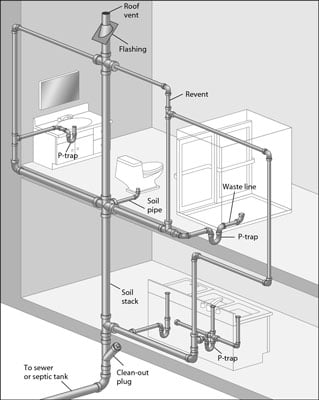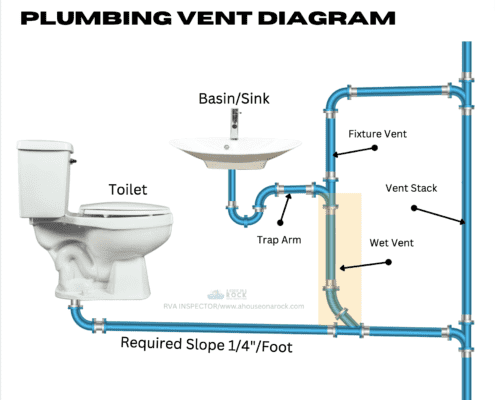How Ventilation in Plumbing Systems
How Ventilation in Plumbing Systems
Blog Article
This article directly below about Essential Plumbing Vent Pipes: Understanding Their Role is extremely entertaining. Give it a go and draw your own personal findings.

Appropriate air flow in plumbing systems is often neglected, yet it is important for preserving the performance and security of your home's plumbing. Ventilation helps manage atmospheric pressure, protect against the build-up of dangerous gases, and make sure the effective removal of waste. In this overview, we will discover the value of appropriate pipes air flow, how it functions, and the benefits it offers your pipes system.
Exactly How Air Flow Works in Plumbing Equipments
Atmospheric Pressure Law
Proper air flow preserves balanced air pressure within the plumbing system. When water flows via pipelines, it displaces air. Without sufficient air flow, this displacement can create adverse pressure, bring about slow drains or siphoning of water from traps, which can create undesirable smells to seep into the home.
Stopping Sewage System Gas Build-up
Among one of the most vital functions of plumbing vents is to avoid drain gases, such as methane and hydrogen sulfide, from building up within the home. These gases can position major health and wellness risks and are highly combustible. Vent pipelines enable these gases to leave safely outside.
Aiding in Waste Removal
Ventilation helps in the reliable elimination of wastewater by avoiding airlocks in the drain system. When air can stream freely with the vents, it allows water and waste to move efficiently through the pipelines, lowering the danger of obstructions and back-ups.
Advantages of Correct Air Flow
Enhanced System Performance
Effectively aerated plumbing systems operate extra efficiently, with less obstructions, faster draining, and less pressure on the pipelines. This efficiency prolongs the life expectancy of the pipes system.
Improved Air Quality
By stopping drain gases from entering your home, correct ventilation contributes to far better indoor air top quality, making your living atmosphere healthier and more comfy.
Avoiding Water Damages
Sufficient air flow assists protect against water from being siphoned out of traps, which can bring about drain gases getting in the home and triggering water damages in time.
Actions to Guarantee Proper Air Flow
Consulting Pipes Codes
Constantly seek advice from neighborhood plumbing codes when designing or customizing your pipes system. These codes supply the necessary standards for proper venting and ensure your system satisfies security standards.
Normal Assessment and Upkeep
Regular examinations can help determine possible ventilation problems prior to they become major issues. Upkeep jobs, such as cleansing vent pipes and checking for obstructions, are crucial for maintaining the system in good working order.
Professional Installation
For new setups or major alterations, it's smart to hire a specialist plumber. They have the knowledge to ensure the air flow system is properly designed and installed according to code.
Comprehending Ventilation in Pipes
Air flow in pipes refers to the network of pipelines that enable air to move with the drain system. These vents serve several objectives, consisting of regulating air pressure within the pipes, stopping sewage system gases from entering the home, and aiding in the smooth flow of wastewater.
Kinds Of Plumbing Vents
Key Heap Vent
The major pile air vent, additionally called the air vent pile, is the key air vent in a pipes system. It prolongs from the primary drain align through the roofing system, enabling gases to get away and fresh air to go into the system.
Branch Vent
Branch vents link to the primary stack air vent and serve individual fixtures, such as sinks, toilets, and showers. These vents guarantee that each fixture has sufficient ventilation to function correctly.
Air Admittance Valve (AAV).
An Air Admission Shutoff (AAV) is a one-way shutoff that permits air to enter the pipes system without the requirement for a conventional vent pipeline expanding via the roof. AAVs are frequently utilized in remodellings or locations where installing a standard air vent is unwise.
Indicators of Poor Air Flow in Plumbing.
Slow Draining Fixtures.
If your sinks, bathtubs, or toilets are draining pipes slowly, maybe a sign of bad ventilation. Insufficient air circulation can produce a vacuum cleaner effect, making it tough for water to drain pipes appropriately.
Gurgling Appears.
Gurgling sounds coming from drains are commonly an outcome of air being drawn with water traps because of unfavorable pressure in the pipes. This is a clear indication of not enough ventilation.
Unpleasant Odors.
Drain smells inside your home are a warning that your plumbing system is not properly aerated. This might suggest that drain gases are not being appropriately vented outside, leading to possibly unsafe conditions.
Usual Air Flow Mistakes.
Poor Vent Sizing.
Using undersized air vent pipes can bring about inadequate air circulation and pressure inequalities in the system. It's essential to make use of vents that satisfy the specific needs of your plumbing system.
Improper Vent Positioning.
Putting vents also far from the components they serve can lower their efficiency. Correct placement makes certain that air can stream freely and successfully through the system.
Disregarding Code Needs.
Building regulations give specific guidelines for pipes air flow. Disregarding these codes can cause a system that fails to work properly and might result in expensive repairs or health hazards.
Conclusion.
Proper ventilation is an essential component of any type of pipes system, making certain that it operates efficiently and safely. By understanding the relevance of ventilation, acknowledging the indications of poor air flow, and taking actions to preserve your system, you can avoid costly concerns and secure your home's air quality.
What is a Plumbing Vent and it's used for?All plumbing systems in residential and commercials construction have a plumbing vent. It doesn’t just vent unwanted odors from the drainage system to the outside; it actually serves an important purpose by supplying air to the system.
The plumbing drainage system is actually called a drainage, waste and vent (DWV) system. When water flows down the piping, an air supply (vent) is needed to allow the water to flow. Think of the vertical pipe as a drinking straw. If you plug the top end of a straw, liquid won’t drain from it.
The DWV system in your building consists of a series of pipes connected to each fixture; they extend above each fixture, and the system terminates at an open pipe that extends through the roof. This piping allows air into the system and prevents unbalanced pressures in the piping.
?The vent also prevents the system from drawing water out of a trap at the fixture with the characteristic “glug-glug-glug” as the drain gasps for air. Plumbing traps should drain smoothly and never “glug” or gasp for air.
If you have a drain that empties slowly or gurgles as it drains, this may indicate a venting problem. If you flush a toilet and the sink gurgles, there’s definitely a vent problem. It is good idea to have a Plumber check this.
https://www.ameliashomeinspection.com/blog/what-is-a-plumbing-vent-and-its-used-for

We were made aware of that write-up on Why Plumbing Air Vents Are Important through someone on a different blog. Those who enjoyed our blog posting please do not forget to pass it around. Thanks so much for your time invested reading it.
Schedule Appointment Now Report this page